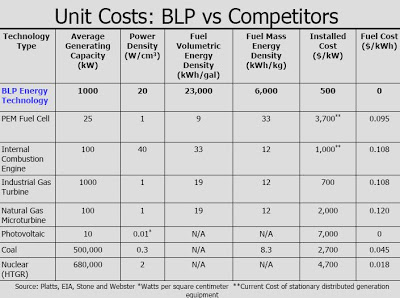Derek Lowe, phd in chemisty, has gotten responses to some of his questions from Blacklight Power. Derek is skeptical but is trying to gain a deeper understanding of what is being done. Blacklight Power seems to be open to providing information and assistance to Derek.
Mills has been good enough to offer to help me out with any aspects of the data that they’ve published, and to get in contact with the company should I be in the area, which is a good sign, and much appreciated. They’re also supposed to have a video of the reaction up shortly, and we’ll see what we can learn from that as well. Against all this, I have to put the fact that I still find the physics behind the company quite odd and improbable. And one has to remember that the track record of odd, improbable physics breakthroughs that promise huge supplies of energy is. . .not good. And that’s putting it very mildly indeed.
But all it takes is one. And all Blacklight has to do to quiet the skeptics (many of whom are much more vitriolic than I am) is to throw that big switch at some point and have the kilowatts (or megawatts) come streaming out. That’ll do it, for sure, and the company assures everyone that this is their goal. I wish them luck with it, because a huge and unexpected new source of energy would be a good thing indeed. I’m actually glad to live in a country where ideas this wild can raise tens of millions of dollars, but (for the time being) I’m also glad that none of that money is mine.
Blacklight doesn’t seem to be trying to extract money from the general public
I’ve heard from some folks at Blacklight Power, including their founder, Randell Mills. He says that I have a number of details wrong about their system, and wrote with more information. I’ll quote from Mills:
”We do not add water to R-Ni. Any water present after drying is in the form of Bayerite or Gibbsite (Al(OH)3) which is quantified by XRD and TPD. Regarding the Rowan University team validation, the maximum theoretical heat from the measured content was 1% of the observed energy as stated with the analytical results given in the Rowan report which is on-line at our website.”
He also takes exception – as well he might – to my line about the correlation of the company’s activities to their fund-raising needs, stating that Blacklight currently has no need to raise any money at all. And as for the NMR figure that I could make no sense of, that appears to have been mislabeled. The one I was looking at, Mills says, is indeed a solution NMR and was actually Figure 45 in the document. Figure 58, he says, has now been fixed, although I have to say that it still looks like a duplicate of Figure 45 this morning at this link.
But as best I understand it now, the fundamental claim of the Blacklight work is that formation of their lower-energy states of hydrogen is extremely exothermic. Alkali metal hydrides, they say, are particularly good catalysts for this, giving you hydrinos and sodium metal (see equations 32 through 34 in their PDF). So the Raney nickel in these experiments is being used as a source of atomic hydrogen, and forming small amounts of sodium hydride on its surface gives you a system to see all this in action. Figure 17 would seem to be one of these, and Figure 21 is the same thing on a kilo scale.

Brian Wang is a Futurist Thought Leader and a popular Science blogger with 1 million readers per month. His blog Nextbigfuture.com is ranked #1 Science News Blog. It covers many disruptive technology and trends including Space, Robotics, Artificial Intelligence, Medicine, Anti-aging Biotechnology, and Nanotechnology.
Known for identifying cutting edge technologies, he is currently a Co-Founder of a startup and fundraiser for high potential early-stage companies. He is the Head of Research for Allocations for deep technology investments and an Angel Investor at Space Angels.
A frequent speaker at corporations, he has been a TEDx speaker, a Singularity University speaker and guest at numerous interviews for radio and podcasts. He is open to public speaking and advising engagements.


